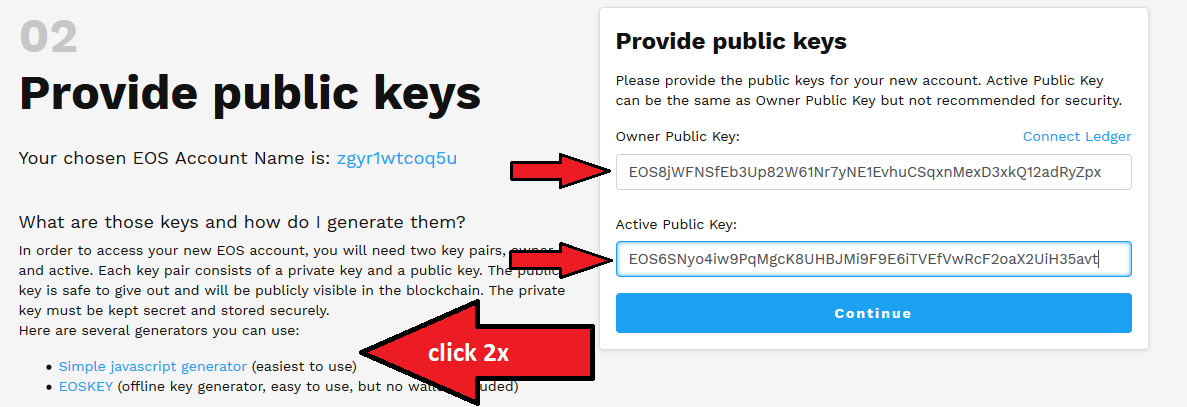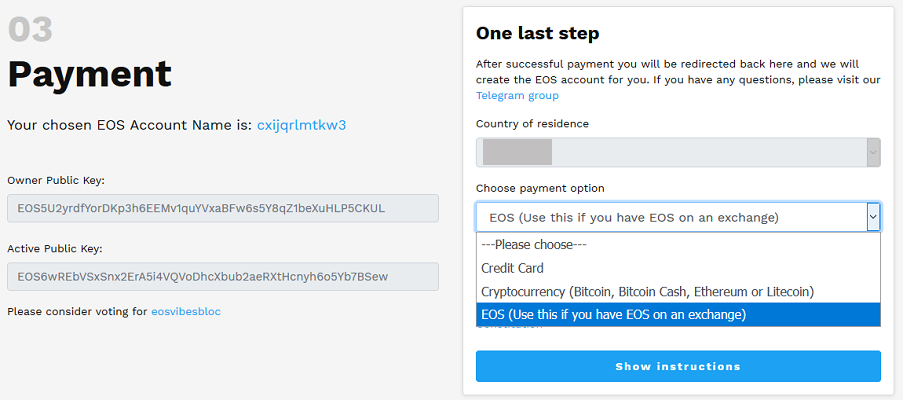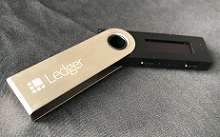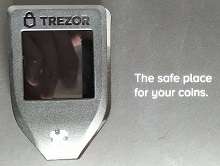In this article we have compiled an overview of the best wallets for the cryptocurrency EOS. Our goal is to give you an overview of the currently available EOS wallets. We would also like to show you the special features of creating an EOS Wallet. In particular, we would like to explain how you can set up an EOS account in the form of an address so that you can then import your private key and address into the wallet.
Before we dive into the topic, however, it is very important from our point of view to have a basic understanding of cryptography (the technology behind cryptocurrencies) and wallets. Therefore, we will first give you a short theoretical introduction to the topic. If you are already well informed, you can skip this part of the post.
You can imagine a wallet like a virtual wallet. In contrast to traditional wallets, however, in a crypto wallet it is not the coins themselves that are stored, but the access keys for them. The access keys are the so-called “private keys”. Depending on whether they are stored online or offline, all wallets can be divided into two types:
- cold wallet
- hot wallet
The distinguishing feature is the connection to the Internet. Cold wallets are the safest way to store cryptocurrencies, as the private keys never come into contact with the Internet. Due to this, hackers have no way to get the access keys to the wallet. In contrast, hot wallets have this point of attack because the private keys are stored on a device that is connected to the Internet.
This serious difference is also the reason why cold wallets are used by large crypto investment companies and cryptocurrency exchanges. In our opinion you should take a role model from this and also rely on a cold wallet solution. Small investors can choose between a paper wallet and a hardware wallet.
Not only cold wallets, but also hot wallets can be divided into three different types. They all have in common that they store the private keys on a medium that is connected to the Internet. The subspecies of hot wallets are:
- EOS desktop wallets
- EOS mobile wallets
- EOS online wallets
The private key is a randomly generated string that represents the ownership of the cryptocurrency. The public key is used to generate the public wallet address (is a hash version of the public key). In contrast to the wallet address, the private key is secret and should never be passed on to third parties. If you have the private key, you can access the wallet address and send the corresponding EOS.
Create an EOS Account
If you want to buy EOS (click here to read our guide) and create a wallet, you will come across a peculiarity that will initially be very confusing for many beginners. You have to create an EOS account! While a few wallets have already integrated this step into their software, others do not, which is why external software must be used.
The “surprising” thing is that new accounts can only be created by someone with an existing account. If you don’t have a friend who has an EOS account, however, there are several websites and tools that can set up an EOS account for you for a fee. In addition, some wallets have already integrated this service to serve as a “friend”.
The best known site is currently: https://eos-account-creator.com/. In the following we want to explain the process to you briefly on the basis of the aforementioned website.
- Step 1: Select Account Name
Once you have accessed the above website, you will need to specify an account name. An EOS Account Name must be exactly 12 characters long and may only consist of small letters and numbers up to 5. You can either make up your own name and check if it is still available or you can click on “I’m feeling lucky” to automatically generate a name.

- Step 2: Generate Private und public keys
Then you have to generate the Private and public keys for your EOS account. To do so, we recommend the “Simple javascript generator”, which can be seen in the middle part of the website. This generator generates a public key and a corresponding private key. The public key is public for everyone. The private key is your secret. Therefore you must write it down on a piece of paper and keep it safe. You can use the first pair of keys for the “Owner” addresses.
After you have entered the “Owner public key”, you have to use the generator a second time for the “Active” addresses. You can enter the public key again on the website (under “Active public key”). The “Active”-private key is again your secret!

The “Active” key is the key you will use for daily operations, such as interaction with dApps or money transfers. This is also the key that you can later enter into a wallet. If this key is compromised, there are “Owner” keys that you can use to restore control over your account and cancel outgoing transfers that have not yet been made, for example. The “owner” key is therefore also very important, since the person who owns it is the actual owner of the account. For both private keys, it is essential that you keep them safe offline.
- Step 3: Payment of the EOS account
The cost of creating an EOS account on the aforementioned website is currently USD 6.37 for payment by cryptocurrency or USD 8.44 for payment by credit card. Included in the price are 0.2 EOS strokes and 4 KB RAM delegated to your newly created account.

- Step 4: Set up an EOS Wallet
In the fourth step you can now download or set up an EOS Wallet. Please note, however, that some wallets have an EOS Account Generator integrated, so you can choose between the generator presented above and that of the wallet. If you have used the EOS Account Creator, you can also import the keys into (almost) any wallet.
The best EOS hardware wallets
Hardware wallets are by far the best option to store cryptocurrencies. They have the highest security standard and are more practical than paper wallets. While the private keys in hot wallets are connected to the Internet, in hardware wallets they are stored exclusively on the device.
Due to the architecture of the hardware wallet operating system, the private key stored in isolation will never have an conntection to the Internet even if an EOS transaction is released. The architecture makes it almost impossible for hackers to gain access to the private key.
In addition, hardware wallets are also very well protected if the device itself is stolen. All hardware wallets presented in the following section have both PIN and 2-factor authentication, making it very difficult to steal the stored EOS from the hardware wallet even in the event of physical theft.
For us hardware wallets are an absolute must-have if you want to invest in EOS or other cryptocurrencies in the long run. In relation to your investment the prices for a hardware wallet are very low. Even our test winner, the Ledger Nano X, is comparatively inexpensive with 120 euros. If this is too expensive for you, you should have a look at the Ledger Nano S, which costs only 60 Euro and offers an unbeatable price/performance ratio.
In the following box we have compiled a summary of the advantages and disadvantages of hardware wallets:
✅ Storage of private keys offline
✅ Support for over 1,000 cryptocurrencies
✅ Confirm each transaction by pressing a button
✅ Regular updates
✅ Very good customer support
❌ No deposit insurance, as with eToro
1.Ledger Nano X
The Ledger Nano X is our test winner of 8 hardware wallets we have tested. Of these 8 wallets, however, only three support the EOS cryptocurrency. One of these is the Ledger Nano X, which was launched on the market in May 2019 as the successor to the Ledger Nano S.
Compared to its predecessor, it has some new features. The most striking change is certainly the new Bluetooth function, which allows the Nano X to be paired with a smartphone. Via the Ledger Live App the Nano X can be operated like a mobile Smartphone Wallet.
Furthermore, the Ledger Nano X contains an improved security chip, which should make the hardware wallet even more secure. In addition, the Nano X has a much larger memory than the Nano S, which means that up to 100 apps for cryptocurrencies, security features, etc. can now be installed on the device. The fourth major change is the enlargement of the display, which makes it much easier to check the EOS address before releasing a transaction.
Conclusion: From our point of view there is currently no better hardware wallet than the Ledger Nano X! Ledger sets a new standard in terms of both functionality and operation that can be surpassed.
2.Ledger Nano S
Although the Ledger Nano S got replaced by the Nano X, there are still good reasons to buy the Ledger Nano S. It has been purchased more than 1.3 million times worldwide, which speaks for a very strong and reliable security of the wallet. So far, no cryptocurrencies have been stolen from the Nano S.
The second big plus point of the Nano S is the currently low price of only 59 euros. Who can live without the new functions of the Ledger Nano X and wants to manage only a small number of cryptocurrencies, e.g. only EOS and Bitcoin, gets a hardware wallet whose price/performance ratio is unbeatable.
3.Trezor Model T
Also in May 2019 SatoshiLabs has presented a new hardware wallet with the Trezor Model T. Just like Ledger, SatoshiLabs has completely redesigned its long-standing success model, the Trezor One, and launched a hardware wallet with numerous new features and improvements.
Compared to the Trezor One, the hardware wallet now supports significantly more cryptocurrencies, which is realized via the new Trezor Bridge software (which is only compatible with the Model T and not the Trezor One). It serves as a “bridge” between the Trezor Hardware wallet and numerous third-party software wallets. In the case of EOS, this is the less well-known Bloks.io Web Wallet. In addition, the Trezor Model T offers the following functions and new features:
- Touchscreen: The Trezor Model T has received a touch screen for releasing the transactions on the device.
- Firmware upgrade: The firmware (Trezor Core) has been completely renewed and improved from a security point of view.
- Faster processor: In addition, the new model has a faster processor, which makes operation even smoother.
- Micro SD card slot: A Micro SD card slot has also been added that can be used for data encryption.
- USB-C port: The old port has been replaced by a modern USB-C port.
Conclusion: The Ledger Nano X performs better than the Trezor Model T in a direct price/performance comparison. The Nano X is around 60 euros cheaper and also has more functions. Nevertheless, the Trezor Model T is one of the best hardware wallets on the market. Supporters of the Trezor wallets point out that, unlike Ledger, the code for all components of the Trezor hardware wallets is open source. It thus offers greater transparency.
The best EOS desktop- and mobile wallets
In contrast to hardware wallets, desktop and mobile wallets are hot wallets. These are programs that are installed on a computer or smartphone. After installation, EOS can be sent and received via the software. However, the wallets differ in some respects with regard to their functional scope.
While EOS specific wallets, such as the Greymass or SimplEOS Wallet, offer the advantage that they are fully compatible with the EOS ecosystem and can be used via decentralized applications (dApps) on the EOS blockchain, multi-coin wallets offer numerous other useful functions. Depending on which functions are more important to you, you should choose your wallet.
If one considers the security standard of desktop and mobile wallets and classifies them in a ranking, they can be classified between hardware and web wallets. Compared to web wallets, they have the advantage that the private keys are stored on your own computer and not on an external server. However, they do not offer by far the same security as a hardware wallet.
Desktop as well as mobile wallets are our top recommendation if you are looking for a free wallet for EOS. Below you will find an overview of the advantages and disadvantages:
✅ Use of the EOS dApp ecosystem (via special EOS wallets)
✅ Higher security than with online wallets
✅ Mobile Wallets: access to EOS via smartphone
✅ Multi-join wallets support over 100 cryptocurrencies
❌ Responsibility to install regular updates
❌ No deposit insurance, as with eToro
Below you will find our top recommendations for secure and reputable EOS desktop and mobile wallets:
- SimplEOS wallet (desktop wallet)
- Infinito wallet (mobile wallet)
- GreyMass EOS Voter wallet (desktop wallet)
- Atomic wallet (desktop – and mobile wallet)
- Exodus wallet (desktop – and mobile wallet)
1.SimplEOS Wallet

The SimplEOS wallet was specially developed for the EOS platform and therefore offers all the functions provided by the EOS.io software. The wallet is developed by EOS Rio, a block producer of EOS, and is recognized as an ‘official’ EOS wallet by the EOS community and other block producers. The wallet only stores the private keys locally. In addition, they can be encrypted with a user-defined password of more than 10 characters. Another advantage is the very clear user interface, which is very easy to use.
The numerous functions of the SimplEOS wallet include:
- Support of airdrops of the EOS ecosystem
- Staking for RAM and bandwidth
- Voting for block producers
- Using EOS dApps
- Contact list and transaction history management
- Creation of multiple accounts
- Importing the Exodus wallet
- Integration of the Block Explorer EOS Flare
It is important to know that with the SimplEOS wallet you can also create an EOS account from within the Wallet. However, payment is only possible in EOS, so you must already own EOS on Binance or another cryptocurrency exchange in order to use this function.
Conclusion: SimplEOS supports practically all functions offered by the EOS ecosystem. In this respect, the SimplEOS wallet is clearly aimed at users who not only see EOS as an investment, but also want to participate in the EOS ecosystem. The software can be downloaded for the Windows, Linux and MacOS operating systems from the official website.
2.Infinito Wallet

The Infinito is a Multi-Coin-Wallet, which is only available as Smartphone version for iOS and Android and is developed by the Infinity Blockchain Group. The wallet was released in 2017 and has since been used by over a million users worldwide.
Since it is a hierarchically deterministic (HD) wallet, the security of the wallet can be rated as good. A password, touch ID and passphrase are available to protect the wallet. In addition, the private keys are stored locally on the user’s smartphone and not on centralized servers. A further security advantage is that the Infinito wallet has been audited by the IT security company Smart Dec.
The great strength of the wallet, however, are the numerous functions that set it apart from other multi-coin wallets and make it the best mobile EOS wallet:
- dApp-Browser for EOS: The dApp-Browser “App Square” enables the user not only to keep his cryptocurrencies, but also to use them in decentralized applications (dApps) of EOS, Ethereum, NEO, Ontology and the Binance Chain.
- Contact management: Frequently used crypto addresses can be stored in a kind of contact management.
- Touch-ID: Touch-ID can optionally be used to unlock the wallet.
- Multilingual: English, French, Russian, Korean, Vietnamese, Chinese and Japanese.
- QR code scanner: Addresses can be imported very easily using the QR scanner.
- Import and export of private keys: Any private key of all supported cryptocurrencies can be imported and exported.
- Crypto credit function: Cryptocurrencies can be loaned via the “crypto lending” function in order to earn passive income.
- Export transaction history: Display and export your own transaction history, filtered by date and cryptocurrency.
Beside these numerous functions there is only one big point of criticism! The Infinito wallet does not offer 2-factor authentication. Furthermore, you should know that the Infinito does not have an integrated EOS Account Generator, so you should use our recommendation, the ‘EOS Account Creator’.
3.Greymass EOS Voter wallet

The GreyMass EOS Voter is a light client and desktop wallet released by Team GreyMass, a block producer of EOS. The wallet was created in the first days of the EOS mainnet because the developers of GreyMass wanted to develop a simple EOS voting tool so that everyone could participate in the EOS Delegated Proof of Stake. In addition to the usual wallet functions, the wallet has the following features:
- Vote on the block producers: Via the wallet you can directly select a block producer you would like to support.
- CPU / Bandwidth Staking: You can stack your EOS for either bandwidth or CPU to get rights to use these resources on the network.
The security of the wallet is very good. When using the GreyMass Wallet, all transactions within the application are signed and the private keys are stored locally on the user’s computer and never transferred to third parties. If a local wallet password is specified, it will be encrypted with AES-256 encryption.
A disadvantage of the wallet is that it is designed to be particularly user-friendly. On the one hand the user interface is a bit confusing, on the other hand a download exclusively from GitHub in the form of a zip file is possible. Thus the installation can already be a first obstacle for beginners. In this respect, from our point of view the wallet is aimed more at advanced users who would like to participate in EOS Staking.
The GreyMass wallet is available via this link to GitHub for Windows and Mac: https://github.com/greymass/eos-voter.
4.Atomic wallet

If you see EOS as a pure investment, don’t want to use EOS decentralized applications and don’t want to participate in the voting of the EOS block producers, the Atomic wallet could be a very good choice for you. The Atomic wallet is a multi-coin-wallet , which addresses itself above all to users, who want to administer different cryptocurrencies in a Wallet.
With over 300 cryptocurrencies, the Atomic Wallet can meet this requirement perfectly. With the multi-coin-wallets there is hardly a Wallet, which can administer a larger number of different cryptocurrencies.
This is probably one reason why the wallet is so popular in the community. It was released in 2017 by Konstantin Gladych, CEO and co-founder of Changelly.com. Another reason is certainly that the developers have focused their development on three central demands of the crypto industry:
- Security,
- Anonymity and
- Decentralization.
In accordance with these requirements, both the private keys and transaction data are stored in encrypted form on the user’s terminal device. Neither the developers nor other third parties have access to it. The third requirement – decentralisation – is implemented by the fact that the wallet has integrated Atomic swaps.
This enables users to exchange cryptocurrencies directly with each other, peer-to-peer, without the need for a third party to act as an intermediary. For cryptocurrencies that are not yet supported via Atomic Swaps, the Atomic wallet provides the Changelly and ShapeShift services integrated into the Wallet.
In addition, the Atomic wallet has a cooperation with EOS, whereby an EOS account can be created from the wallet, as the following video shows.
The wallet is available on the official website for Windows, Mac, Ubuntu, Debian and Fedora. The mobile versions for iOS and Android are also available from the App Store and Google Play Store.
5.Exodus wallet

The Exodus wallet is also a Multi-Coin wallet that can manage more than 100 cryptocurrencies and display their value in over 30 different Fiat currencies. The wallet is one of the oldest Multi-Coin wallets on the market and was released in July 2016. The wallet has three main components:
- the Multi-Coin Wallet,
- a portfolio tracker (in 30 Fiat currencies)
- and an integrated exchange service from ShapeShift.
In addition to these functions, the Exodus wallet offers a good basic protection for your EOS. Neither the developers nor other third parties have access to your private keys, as they are stored locally and encrypted on your computer. However, in the crypto community there are also two criticisms of the wallet.
For example, the backup function by e-mail is criticized because sending by e-mail is classified as potentially insecure. On the other hand, the lack of the possibility of two-factor authentication is criticised. Both facts show that the security can be classified as rather mediocre, since attackers only have to hack the password via the e-mail backup and then already have full access to the wallet.
From the point of view of EOS users, there are also three other disadvantages:
- EOS Airdrops are credited to the account, but cannot (yet) be accessed or managed via the Exodus Wallet. The Airdrop tokens can only be viewed in EOS Block Explorer.
- Currently, it is not possible to vote for block producers within Exodus. For this you have to use another wallet like GreyMass Voter, SimplEOS or Scatter.
- It is currently not possible to create multiple accounts within Exodus.
If these are not K.O. criteria for you, you can follow the link, which will take you directly to the official website of the wallet (click here!). The wallet is available as desktop version for Windows, Mac and Linux. Smartphone versions for iOS and Android are also available.
The best online wallets for EOS
The great advantage of online wallets is that they can be set up very quickly and used immediately. Unlike the other wallets, no installation or backup is necessary. All users have to do is create an account and usually enter only a small amount of information.
It is important to know that there are two types of online wallets. The better known type are the wallets of the cryptocurrency exchanges. They offer the advantage that the user not only owns a wallet but can also use the trading platform to trade and buy cryptocurrencies. This is probably also the main reason why exchange wallets are among the most popular wallets, although they have some serious disadvantages.
Thus the private keys are stored by the cryptocurrency exchange. As a result, users must be confident that the vendor is storing EOS and other cryptocurrencies securely and protecting them from hacker attacks. The second type are EOS-based specific developments of online wallets. In this category there is currently no recommended wallet from our point of view, after the Scatter web wallet was discontinued and is now only available as a desktop version.
Below we have compiled an overview of all the advantages and disadvantages of online wallets:
✅ Exchange wallets enable trading out of the Wallet
✅ In the case of exchange wallets, there is no installation work required.
✅ You can define limits for maximum payouts per transaction.
✅ The user interface is often very simple and intuitive.
✅ Often very good customer support
❌ The management of the private keys is (often) transferred to a third party.
❌ Danger of market hacks
❌ Some web wallet vendors have turned out to be scam in the past
- Binance
- eToro
1.Binance wallet

Binance is one of the best options for an exchange wallet if you want to trade with cryptocurrencies. Binance has earned a very good reputation over the past few years and is therefore very popular in the crypto community. Nevertheless, you should be aware that storing your EOS on Binance is the most insecure storage solution. The Private Keys are owned by Binance and are stored by the exchange on the company servers (or cold storages).
In May 2019, Binance experienced one of the biggest hacks (after Mt. Gox) in Bitcoin’s young history when 7,000 BTCs were stolen when a vulnerability in the Binance API was exploited. Even though Binance took responsibility for the hack, did not pass the loss on to its customers and significantly increased its security measures after the hack, this clearly demonstrates the vulnerability of exchange wallets.
Our tip is therefore that you should only use the Binance wallet as long as you actively trade in cryptocurrencies. For long-term storage, you should transfer EOS to another wallet, preferably a hardware wallet.
If you would like to register an account on Binance, you can do so via this link*.
2.eToro wallet

Our second choice is eToro, which, however, only appeals to residents outside of the US and UK (as of 01/2021). eToro is one of the largest CFD providers in the world and offers various cryptocurrencies in “physical form” as well as CFD (outside of the two aforementioned regions). Due to its high security standards and reputation, eToro can be a good option for custody in our view.
For more information, you can read our eToro review. If you want to sign up for the wallet, you can use this link (click here*) to create an account with eToro.
**68% of retail investor accounts lose money when trading CFDs with this provider. You should consider whether you can afford to take the high risk of losing your money.
Cryptoasset investing is unregulated in some EU countries and the UK. No consumer protection. Your capital is at risk.
Below we have summarized the advantages and disadvantages of Web wallets:
Exchange wallets are very convenient and practical, because you can trade cryptocurrencies without any major detours. However, they have the serious disadvantage that you are not in possession of the Private Keys and exchanges are popular targets for hacker attacks. You should therefore never keep EOS permanently on an exchange such as Binance, Bitfinex, CEX.IO or Bittrex.
Further important information about the EOS wallet test
The information presented was compiled to the best of our knowledge and experience. Therefore, you should gather more information yourself and test different wallets to find the best one for you.
Subscribe to our daily newsletter!
No spam, no lies, only insights. You can unsubscribe at any time.
If you have any questions or suggestions about our EOS wallet test, please leave us a comment. We’ll be glad to help you! If you liked this article about the best EOS Wallets, we would appreciate a positive review!
[ratings]







